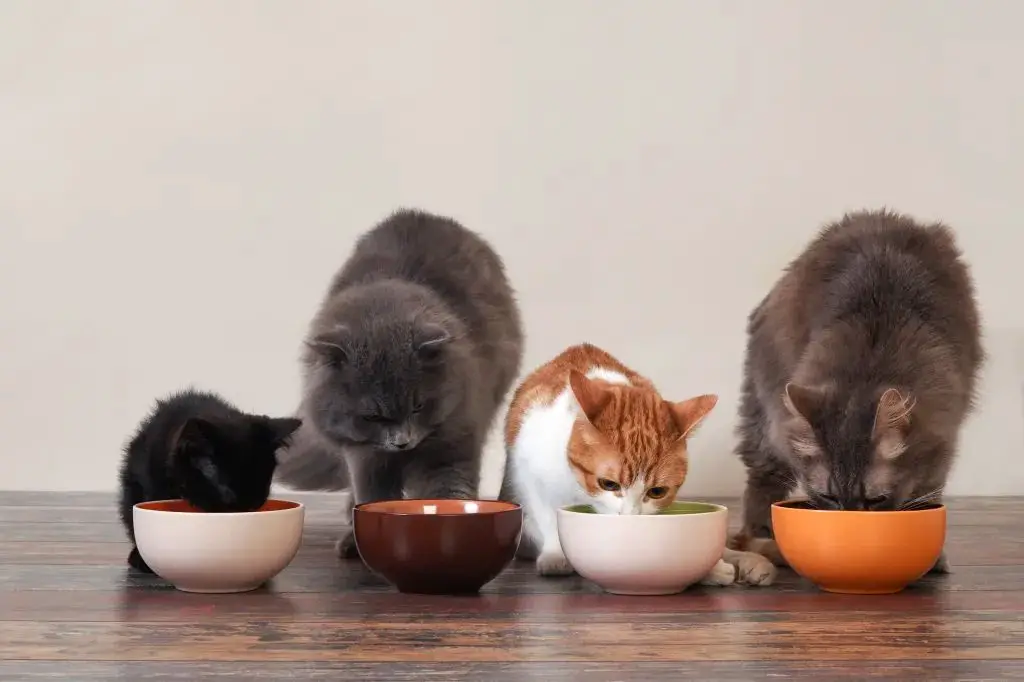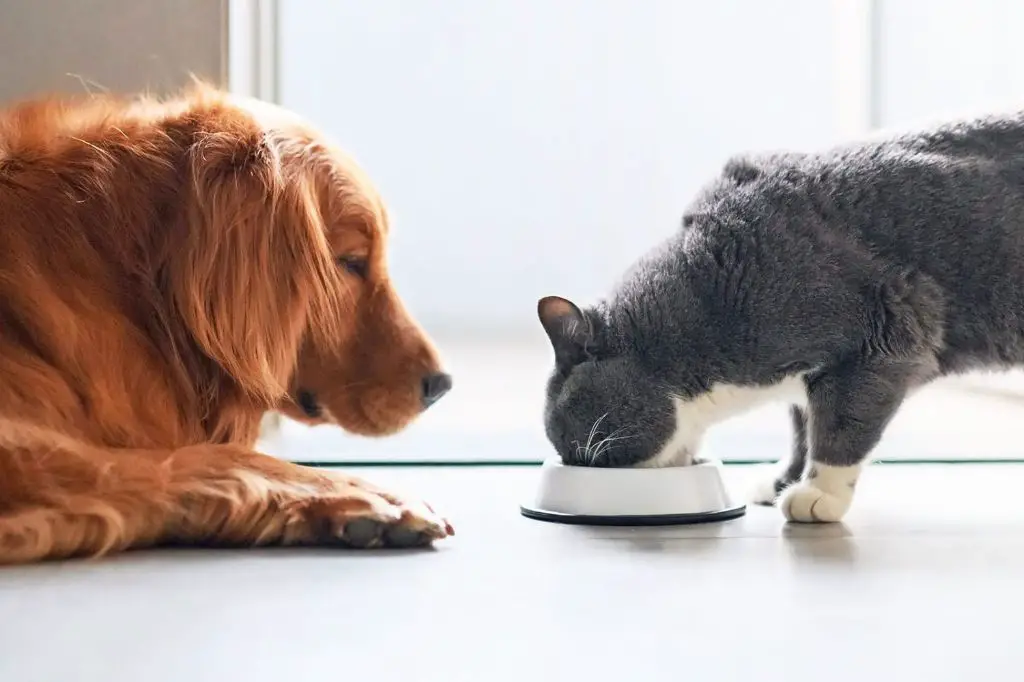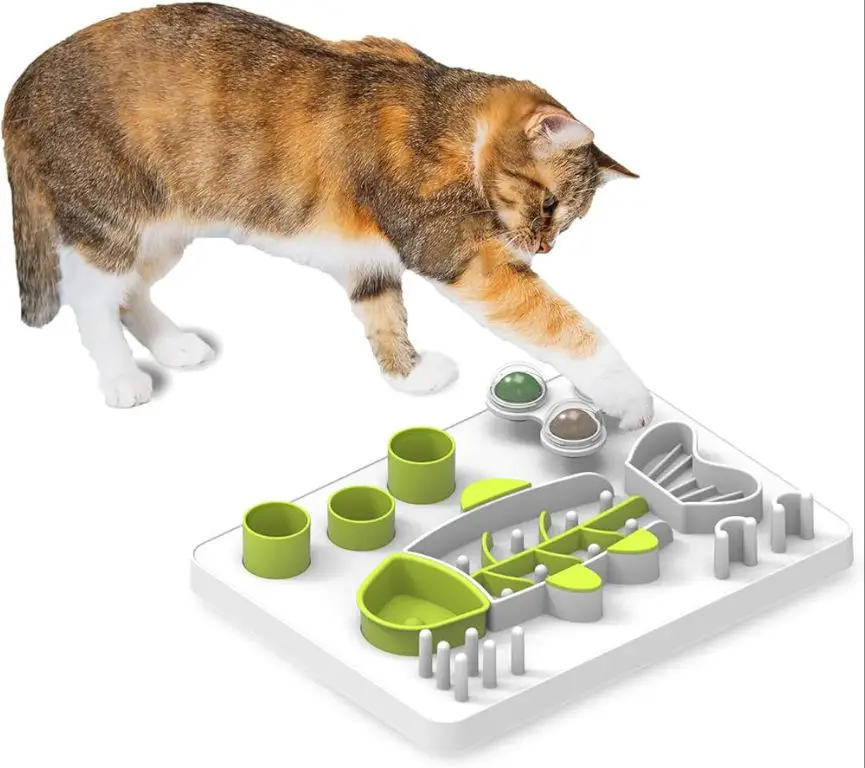Understanding Why Dogs Eat Cat Food
Dogs have a natural scavenging instinct and are opportunistic eaters. They will eat whatever food is available, even if it’s not designed for them. Cat food is much higher in protein and fat than most dog foods, which makes it more appealing to dogs. The strong meat smell and flavor of cat food is very enticing to dogs (source).
In addition, dogs may eat cat food due to boredom, anxiety, or lack of training. When dogs experience these states, they may seek out inappropriate items to chew or consume. Cat food left unattended provides an easy target for this behavior. Providing proper exercise, mental stimulation, and training can curb food-driven behaviors (source).
Health Risks of Dogs Eating Cat Food
There are several health risks associated with dogs eating cat food regularly or in large quantities:
Nutritional imbalance – Cat food is higher in protein and fat than dog food. It also contains higher mineral levels that can be problematic for dogs over time. The nutritional imbalance can lead to obesity and other health issues in dogs (source).
Weight gain – The higher fat content in cat food compared to dog food can quickly lead to weight gain in dogs. Obesity in dogs raises the risks of joint problems, heart disease, and diabetes (source).
Pancreatitis – The high fat content in cat food puts dogs at risk for developing pancreatitis, which is an inflammatory condition that can range from mild to life threatening (source).
Gastrointestinal issues – Cat food is richer than dog food and the higher mineral content may irritate a dog’s digestive tract. Vomiting, diarrhea, and constipation can occur after a dog eats cat food, especially in dogs with sensitive stomachs.
Feeding Cats Separately
One of the most effective ways to prevent dogs from eating cat food is to separate the cats’ feeding area. This ensures the cats can eat their food without interference from the dog.

Feed cats in a separate room that the dog can’t access. Close the door securely, and make sure the room is “dog-proofed” with no other entrances the dog can get through. You can also use baby gates in doorways or hallways to block the dog’s access.
Elevated cat feeding stations are another option. Place the cat’s food bowls on a table, counter, windowsill, or cat tree that’s too high for the dog to reach. Just be sure to monitor that the cat can comfortably access the station.
By feeding cats in an area the dog can’t get to, you remove the opportunity for the dog to eat the cat’s food. Pay close attention at first to ensure the dog doesn’t find ways around the barriers.
Sources:
https://www.petsafe.com/blog/how-to-keep-dogs-cats-away-from-each-others-food/
Use Meal-Feeding for Dogs
One of the best ways to prevent your dog from eating your cat’s food is to feed your dog at scheduled meal times instead of free-feeding. With meal-feeding, you give your dog a measured portion of food at set times once or twice a day. This helps create a predictable routine so your dog learns when to expect meals.
The steps for meal-feeding a dog are:
- Pick set meal times, such as morning and evening.
- Portion out the proper amount of food for your dog based on their weight, age, and activity level.
- At each meal time, put down your dog’s bowl and allow them 10-15 minutes to eat.
- Promptly pick up the bowl after this time, even if your dog doesn’t finish.
- Do not leave food out all day for your dog to graze on.
Studies show that meal-feeding once a day is associated with better health outcomes in dogs compared to free-feeding. It can help prevent obesity, improve digestion, and create a predictable routine.

With scheduled meal times, your dog will learn to eat when their food is down and avoid grazing throughout the day. This takes away opportunities for them to eat the cat’s food. Be patient during the transition and keep to the schedule. Soon your dog will adapt to meal-feeding at consistent times.
Use Puzzle Feeders for Cats
Puzzle feeders can be an effective way to slow down your cat’s eating and provide mental stimulation while limiting your dog’s access to the cat food. Puzzle feeders like the Food Puzzles for Cats products feature different compartments, levels, and obstacles that require cats to “work” for their food. This slows down their eating compared to a regular bowl, which can help prevent issues like vomiting and indigestion. The mental challenge also provides important enrichment for cats.
Puzzle feeders for cats are designed to be difficult for dogs to access. They often have narrow openings or require certain actions that are easy for cats but hard for dogs. You can monitor your dog’s initial reactions to the puzzle feeder and consider placing it in an enclosed cat-only feeding area if needed. Just be sure to introduce the new feeding method gradually to allow your cat time to adjust.

Some examples of cat puzzle feeders include the ALL FOR PAWS Interactive Cat Puzzle Feeder and products from the Cat Puzzle Feeder category on Amazon.
Train Your Dog
One of the most effective ways to stop your dog from eating your cat’s food is to train them to leave it alone. The “leave it” command is very useful for this. Start by putting your dog on a leash and placing them near the cat food bowl. When they go for the food, firmly say “leave it” and guide them away with the leash. Praise and reward with a treat when they resist going for the cat food. Repeat this over multiple training sessions until your dog reliably leaves the cat food when commanded.
You can also train your dog by rewarding them when they ignore the cat food. For example, place your dog on a leash a few feet from the cat food bowl. When they look at but don’t approach the food, mark the behavior with a “yes!” or click and give them a treat. Keep reinforcing leaving the cat food alone and not showing interest in it. With time, your dog will learn to pass by the cat food without trying to eat it.
Using a crate when you can’t directly supervise can also be helpful. Place your dog in their crate with a chew toy before feeding your cat. This prevents access to the cat food. You can also feed your cat in a separate room with the door closed. Just be sure your dog gets adequate exercise and enrichment when crated for periods of time.
Use Aversives Strategically
Using aversives or deterrents can be an effective way to keep dogs away from the cat’s food. Some humane yet unpleasant options include:
Bitter apple spray – This non-toxic spray has a very bitter taste dogs dislike. Spray it directly on the cat’s food and bowls. The bad taste will deter dogs from eating the cat’s food. Reapply frequently, as the spray can wear off. See (source).
Scat mats – These are mats that give a mild static shock when stepped on. Place them around the cat’s food bowls. The shock will startle dogs away. Look for humane low-level mats designed for pet training. Do not use electric mats made for livestock.
Motion-activated devices – These can be spray deterrents, sirens or other devices that activate when a dog approaches. They startle dogs away from the area without harm. Place them strategically near the cat’s food. Only use pet-safe, humane devices.
Be very consistent, use verbal cues like “no” when activated, and never use inhumane shock or pain. The goal is to make the cat’s food area very unpleasant for dogs, so they learn to avoid it entirely.
Consider Prescription Dog Food
One option to deter dogs from eating cat food is to switch your dog to a prescription dog food diet. These foods are formulated to be less appetizing to dogs while still providing complete and balanced nutrition. Most prescription dog foods require consultation from your veterinarian.
Prescription dog foods contain certain nutrients, flavors, or textures that make them unappealing for dogs to eat but don’t compromise their nutritional needs. For example, some prescription dog foods have a very bland flavor profile that dogs won’t find tasty. The food meets all of your dog’s dietary requirements, but the boring taste helps curb food-motivated behaviors like stealing a cat’s food.
Some popular prescription dog food brands to consider include: Hills Prescription Diet, Royal Canin Veterinary Diet, and Purina Pro Plan Veterinary Diets. Consulting with your vet is an important first step, as they can recommend a specific prescription formula tailored to your dog’s needs and issues.
The vet will need to authorize and provide a prescription for these foods. So make an appointment to discuss whether prescription dog food could help curb your dog’s cat food thievery.
Address Any Underlying Causes
Sometimes a dog’s urge to eat a cat’s food stems from underlying issues like anxiety, boredom, or even hunger. If your dog seems obsessed with the cat’s food no matter what you try, it’s worth examining and addressing any underlying causes.

Increasing daily exercise and playtime can help relieve anxiety or boredom that may drive your dog to eat the cat’s food. Interactive games, dog sports, and daily walks are great ways to provide productive mental and physical stimulation. Providing food puzzles like snuffle mats or Kongs can also engage your dog’s natural scavenging instincts in a healthy way.
If your dog acts excessively hungry and seems to scavenge for any food sources, discuss this increased appetite with your veterinarian. They can check for any medical issues and ensure your dog is getting adequate nutrition from his own food. In some cases, switching to a prescription dog food formulated for hunger satisfaction may help.
While getting to the root of any behavioral or medical issues takes time and patience, addressing underlying problems is key to permanently stopping food stealing behaviors in dogs.
Be Vigilant and Patient
Dog behavior issues often require time and consistency to resolve. When training your dog to stop eating the cat’s food, you’ll need to supervise all meal times closely. This allows you to catch your dog in the act and redirect them before they access the cat’s food. Be ready with treats or toys to immediately engage your dog in another activity as soon as they start approaching the cat’s dishes.
Reinforcing training constantly is key – practice short training sessions multiple times a day to help your dog learn faster. Teaching a ‘leave it’ command can be helpful for redirecting your dog when they’re fixated on the cat food. Always reward and praise your dog for leaving the cat food alone. It may take weeks or even months of diligent training before your dog reliably ignores the cat food, but stay positive and keep at it.
With time and consistency using positive reinforcement, you can teach your dog to resist the temptation to eat the cat’s food. But remain watchful of their interactions with the cat dishes, and be prepared to intervene. Don’t get discouraged by setbacks. Staying patient while vigilantly supervising, training, and rewarding your dog will eventually lead to success.

